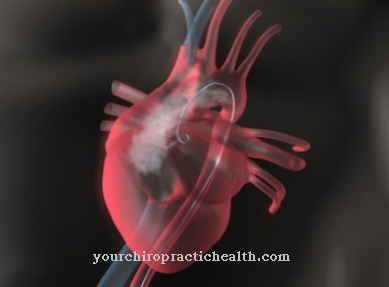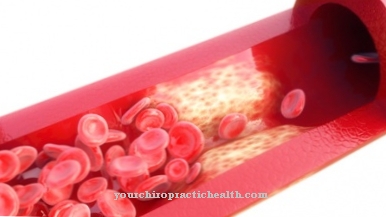Sometimes it is necessary to examine the lymph nodes and the drainage routes around them. Reasons for this can be, for example, hardened or enlarged lymph nodes, which require closer inspection by a specialist doctor. The procedure used for this is called Lymphography (also Lymphography) designated.
What is lymphography

Lymphography is a method based on radiation diagnostics to show the lymphatic channels and nodes. Various substances are injected to make the affected tissue more visible. Various process technologies can be used for this purpose.
In the meantime, this examination method has been almost completely replaced by sonography, MRI and CT. This applies in particular to the purely diagnostic procedure. It is still used primarily for surgical or accident-related injuries to the lymphatic system that cannot be localized otherwise. In some cases, poppy seed oil can cause the injury to stick together so that further interventions are no longer necessary. Lymphography is therefore still suitable for certain medical questions. This also applies to cases in which computed tomography and magnetic resonance tomography reach their limits. Other common names are Lymphangiography or Angiography of the lymphatic vessels.
Function, effect & goals
Lymphatic tracts in the limbs and lymph node images near the main artery and in the armpit and lumbar area can be mapped using lymphography.
In addition to injuries, various diseases can be examined using this procedure. These include lymphedema, which particularly affects the main trunk, as well as tumors in the area of the lymph nodes. Edema is congestion with accumulation of fluid that leads to discomfort. In the area of tumors there is, on the one hand, the possibility of daughter tumors (metastases) that originate from other cancers. On the other hand, it can also be lymphoma. Other rarer diseases of the lymphatic system can also be detected in some cases via lymphography.
The examination is a contrast agent examination, which is also suitable for checking the healing process of a previous injury. Lymphography is necessary, for example, if fluid builds up in the chest cavity after an injury. The doctor speaks of a so-called chylothorax. Depending on the amount of fluid, the functions of the heart and lungs can be restricted. Another possibility is the accumulation of fluid in the pericardium or abdomen.
Tumors, however, trigger an enlargement and hardening of the respective lymph nodes. While pain is often delayed, in some cases those affected complain of more unspecific symptoms such as fatigue, night sweats and fever. Weight loss and decreased performance are also possible, and other imaging modalities that complement lymphography may help diagnose. These include normal x-rays, ultrasound, as well as the aforementioned CT or MRI. If a tumor is suspected, the attending physician will also take a biopsy. Lymphography is one of the methods used to make a differential diagnosis.
The course of lymphography is firmly regulated. The patient is advised to stay in bed for a long time and should be sober, otherwise there is a risk of anaphylactic shock. Medicine differentiates between direct and indirect lymphography. In direct lymphography, a contrast agent is injected into the back of the foot to make the vessels visible. This procedure is done with a very fine needle under local anesthesia. The lymph vessels absorb the dye and transport it away, making the pathways recognizable. During the injection and at further intervals up to 32 hours after the procedure, the lymphatic pathways are recorded via X-rays. Another possibility is the double X-ray examination: once immediately after the procedure and again around 24 hours later.
In indirect lymphography, a dye is injected under the patient's skin and transported via the tissue lymph into the surrounding lymph nodes and pathways. This makes them visible during the X-ray. This procedure is mainly used for inflammatory diseases.
You can find your medication here
➔ Medicines against swelling of the lymph nodesRisks, side effects & dangers
Lymphography is generally a relatively low-risk procedure. Nevertheless, side effects or complications can occur.
Often lying down for a long time during the injection is perceived as uncomfortable. Therefore, it is advisable to have distraction such as music or a book on hand. In rare cases, the drugs injected into the person can cause allergic reactions. A less dangerous but annoying side effect is a possible discoloration of the skin and urine due to the injected dye, which however subsides after a few days. After direct lymphography, a blue coloration remains on the back of the foot for up to two weeks.
Injection site infections are very rare, as are anaphylactic reactions. When the administered medication enters the lungs, a dry, irritating cough can occur. In severe cases, it can develop into pneumonia. Other possible complications include headache, nausea, and an increase in body temperature. In some cases, nerve damage or scarring can also occur.
The radiation exposure from the X-ray is extremely low. The exposure depends on the number of pictures taken and the amount of activity administered. Other imaging methods show a similar radiation exposure. Only magnetic resonance imaging does not use ionizing radiation. Lymphography has the advantage of being more accurate than ultrasound or CT. In addition, it is particularly suitable for the early detection of lymph node metastases, even if these are not enlarged. Nevertheless, the examination is very complex and is only rarely used. Hence, the number of medical professionals who master them is decreasing. In addition, the process is quite error-prone, which means that it is only of limited significance.



























